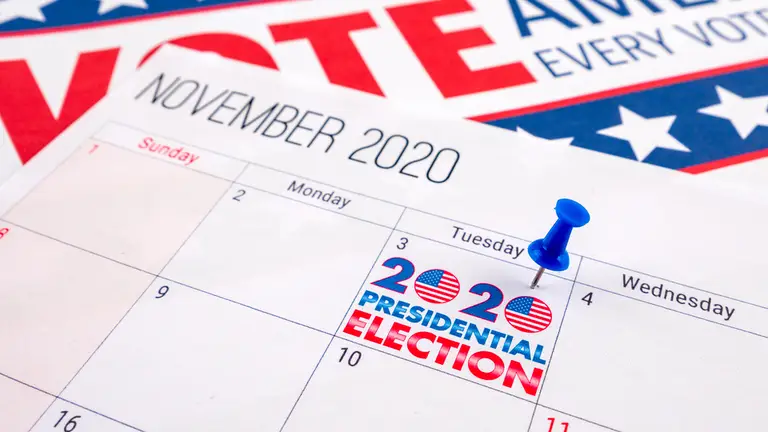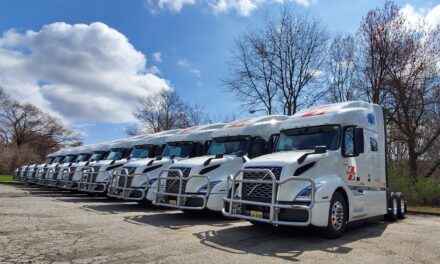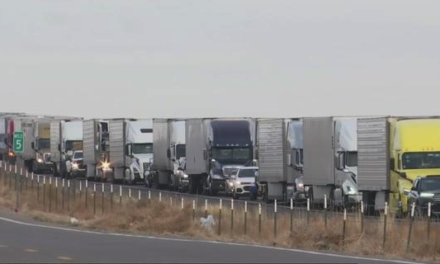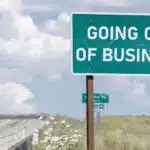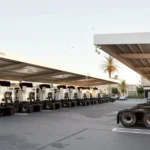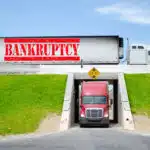The 2020 U.S. presidential election has been built up as the biggest election in the nation’s history, but regardless of if President Donald Trump or former Vice President Joe Biden wins, life will continue to be challenging for the trucking industry.
When the winner is inaugurated on Jan. 20, 2021, a wide swath of America’s roads and bridges will still be in disrepair, carriers will still have a tough time finding drivers to meet the growing freight capacity, and questions will still remain over how to pragmatically shift to cleaner trucks that emit fewer or no emissions. Add the mitigation and recovery from the COVID-19 pandemic to that list of pre-existing conditions and the overall problem is way more than any single president could be expected to bear alone.
The overall trucking industry infrastructure, which includes surface infrastructure such as highways and rest stops, but extends to the people, trucks, and supporting equipment, is substantial. There are more than 4 million miles of roads, nearly 4 million commercial driver’s license holders, and 37 million registered commercial-use trucks, with the Class 8 segment comprising 3.9 million of those vehicles.
That size commands funding, governance, and regulations from multiple agencies at the federal, state, and local levels. Aside from the occasional steering of high-level conversations around national policy and sentiment and of course, approving bills, the commander-in-chief is basically a back-seat driver. Congressional committees, lobbyists, and stakeholders collaborate to ultimately craft the legislation that will ultimately impact the industry.
And when the going gets too tough on the legislative front, a president can shift his attention to any number of hot-button issues from foreign relations to health care. However, truckers must keep their focus on the road ahead, which oftentimes have been neglected.
“It doesn’t matter whether it’s Trump or Biden, our nation needs infrastructure—it’s literally crumbling in places,” said Don Lefeve, president and CEO of the Commercial Vehicle Training Association (CVTA).
In its 2017 Infrastructure Report Card, the American Society of Civil Engineers (ASCE) gave the U.S. infrastructure a D+, a grade. The 2013 grade was the same. This groups several different categories, from drinking water to aviation to schools. Regarding surface infrastructure, bridges scored a C+ and roads a D.
“Without good roads, you have congestion, you have road repair issues that can cause wear and tear on the vehicle,” Lefeve said. “Ultimately it is a commerce issue, a safety issue, and national security issue. The strength of our country is really our economy.”
Trucks hauled 72.5% of the nation’s total domestic tonnage in 2019, so poor roads don’t just cost drivers and fleets time and money. Everyone pays.
“Failing to act to rebuild America’s infrastructure costs every American family $3,400 a year, and the costs and consequences to our economy are significant,” wrote ASCE President Norma Jean Mattei in the 2017 report.
ACSE assigned a price tag of $2 trillion to address all the infrastructure issues, with Mattei arguing not for “one-time, short-term patches and small-scale investment increases” but rather “through bold leadership, thoughtful planning, and—most importantly—sustained, strategic investment.”
Three years later, the nation is still waiting.
Differing plans
The 2015 Fixing America’s Surface Transportation (FAST) Act, which was set to expire Sept. 30, received a one-year extension when President Trump signed the continuing resolution. This will add $13.6 billion to the Highway Trust Fund.
Essentially, it’s a Band-Aid on a gaping wound. Both Democrat and Republican sides of the aisle have taken a crack at a long-term answer to patch the crumbling infrastructure.
Earlier in the year, the House Democrats sponsored the five-year, $494 billion Investing in a New Vision for the Environment and Surface Transportation in America (INVEST in America) Act. The bill had $319 billion earmarked for highway investments and sought to fix those existing bridges and roads, remove traffic gridlock, reduce greenhouse gas emissions, and improve safety.
“The bulk of our nation’s infrastructure—our roads, bridges, public transit and rail systems, the things that hundreds of millions of American families and businesses rely on every single day—is not only badly outdated, in many places, it’s downright dangerous and holding our economy back,” said Rep. Bill DeFazio (D-Ore.), chairman of the House Committee on Transportation & Infrastructure. “Yet for decades, Congress has repeatedly ignored the calls for an overhaul and instead simply poured money into short-term patches. The result? We’re still running our economy on an inefficient, 1950s-era system that costs Americans increasingly more time and money while making the transportation sector the nation’s biggest source of carbon pollution.”
This summer, the INVEST Act was lumped into a larger $1.5 trillion Moving Forward Act, which also aimed to address clean water, internet access, schools, housing, and more. That bill failed to get support from the Republican-controlled Senate.
The Republican members of the House Transportation & Infrastructure Committee, led by Rep. Sam Graves (R-Mo.) answered with the Surface Transportation Advanced through Reform, Technology, & Efficient Review (STARTER) Act.
The key goals of the STARTER Act were to bring more state flexibility, streamline the project delivery process, address rural infrastructure needs, and provide long-term sustainability for the Highway Trust Fund.
“The majority’s bill that was approved in committee today isn’t going to get signed into law, and the only path to improving our infrastructure and putting Americans back to work is through partnership, not partisanship,” said Rep. Graves at the time.
He called it the “My Way or the Highway Bill,” due to its “partisan agenda” and criticized his Democrat colleagues for wanting to fund the bill by doubling the gas tax “at a time when so many Americans are struggling to make ends meet because of the pandemic.”
Furthermore, he said 40% of the funding related to reauthorizing surface transportation programs was connected to address Green New Deal mandates.
The sweeping Green New Deal legislation includes the Climate Equity Act introduced in August by Joe Biden’s running mate, Sen. Kamala Harris (D-Calif.), and Rep. Alexandria Ocasio-Cortez (D-N.Y.). That bill calls for an end to the use of fossil fuels, the creation of more clean economy jobs, and creating equity for those affected by “systemic socioeconomic disparities, environmental racism, and other forms of injustice.”
“We need a Green New Deal based on climate and environmental justice, which means building a clean economy that protects communities that have been neglected by policymakers for far too long,” Sen Harris said.
If the Democrats were to take back the Senate and presidency, while also keeping the House, it’s likely a version of the Green New Deal would ultimately end up on a President Biden’s Oval Office desk for final approval. His website outlines $2 trillion worth of infrastructure goals to slow human-induced climate change while transforming the auto industry and power sector, and enact environmental justice reforms. Millions of union jobs paying at least $15/hour would also be created.
How this spending would be paid for, when also considering the Democrats are running on reforming health care, is vague. Biden has often said he plans to increase taxes on the wealthy and large corporations.
If President Trump is re-elected and has a Republican-led Congress to support him, some form of his $1 trillion infrastructure bill may get passed. This includes $810 billion to repair and replace surface infrastructure and transit over the next decade.
Trump has been criticized by his opponent for not getting any infrastructure changes passed in his first term, though it was part of the Trump 2016 platform.
The Cato Institute, a libertarian think tank, noted that this Trump plan will have funding issues, as the federal gas tax has not been raised since 1993, and factoring in inflation and better fuel economy, drivers pay only 40% per mile of what they did 27 years ago.
Whatever either side’s plan ends up looking like after going through the many committees and markups, the big question will be how the nation will pay for it.
“We all support investing in our infrastructure, but we can’t pretend we’ve got a blank check to do it,” Rep. Graves noted. “Money doesn’t solve all problems, and if we don’t learn from the mistakes of the Obama-era stimulus spending then we are bound to repeat them.”
Sen. John Barrasso (R-Wyo.), chairman of the Senate Committee on Environment and Public Works (EPW), held a hearing this summer when the INVEST Act was being proposed highlighting the urgency of the matter.
He said the Highway Trust Fund was projected even before the pandemic to reach insolvency by mid-2021.
“Now, with Americans driving less, the Highway Trust Fund will reach insolvency far sooner than first predicted, Sen. Barrasso said. “The time for Congress to pass meaningful, bipartisan infrastructure legislation is now.”
To speed up the action, the EPW Committee proposed America’s Transportation Infrastructure Act which would cut environmental review time from seven years to two years.
Trucking perspective
America’s infrastructure may have scored a D+, but its politicians are failing.
“The federal government’s big role, in our opinion, is to provide some sort of long-term, equitable funding that they can distribute to state and local communities to invest in roads and bridges,” said Mike Matousek manager of government affairs for the Owner-Operator Independent Driver Association (OOIDA). “That’s the way it should work. That’s not really the way it has worked.”
He did note that removing and consolidating various federal programs and focusing on core surface infrastructure issues have been bright spots, but “revenue diversion is still rampant in (Washington) D.C.” And all of these proposed bills have “no idea where the revenue is going to come from.”
One probable source he sees as a golden goose is the truckers OOIDA represents, which he called “rolling piggy banks” in the eyes of the government.
“Some of what we see from the federal government, and from state legislatures across the country, are effectively attacks on small business truckers through legislative proposals,” Matousek argued. “There are some taxes that drivers pay that really shouldn’t exist. And some that they do pay should be dedicated to projects that will actually provide some level of benefits for them.”
He cited diesel taxed at a higher rate than gasoline as one example.
OOIDA did like some of what was in the INVEST Act and actually endorsed it, but the poison pill was a markup that increased federal insurance requirements for motor carriers from $750,000 to $2 million in liability insurance coverage.
“What started off as a relatively non-controversial highway bill became extremely controversial,” he recalled.
Matousek said the major problem is trying to pass a highway bill within the framework of a larger infrastructure bill. When he worked on Capitol Hill in 2006, he heard congressmen talk about the same issues “and they’re not any closer to addressing this issue than they were 14 years ago,” he said.
“The larger those bills, more than likely, they aren’t actually getting done,” he said.
He acknowledged that if the Democrats control the executive and legislative branches, a lot of what was in the INVEST Act would become public law. If Rep. DeFazio can keep his seat, that may bode well for truckers.
Matousek said OOIDA has a “great relationship” with DeFazio and his staff, and he has been “pretty fair.” OOIDA also liked that both have given attention to new truck parking capacity projects. The Democrat bill called for $250 billion to fund additional parking, to limit detention time, and other trucker-specific provisions.
OOIDA could also possibly support “modest increases to the federal gas and diesel taxes.”
“We could probably get behind something like that, depending on where that new revenue goes, which is going to be a sticking point between Republicans and Democrats without question,” Matousek said.
